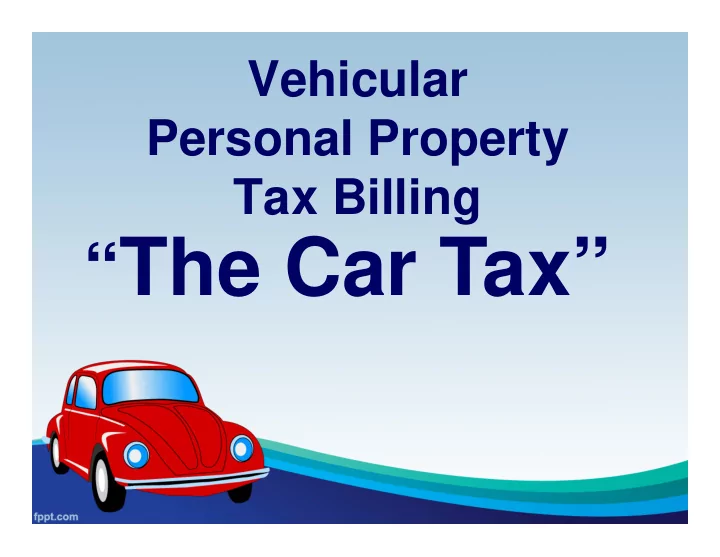

Vehicular Personal Property Tax Billing “ The Car Tax”
Driving Force The City’s old software has reached the end of its useful lifetime. New technology will meet the City’s needs and our citizens’ requests but cannot handle our unique billing methodology.
Goals • Provide information to the public on transitioning from the City’s unique Annual Cycle Billing to Standard Billing in preparation for new technology • Prepare citizens to take an active role in providing feedback to City Council
Topics • Background • Where we are now • Where we wish to be • How we get there with the least negative impact on our taxpayers
Background • All Virginia localities have personal property taxation: Includes cars, trucks, motorcycles, RVs and such
Who Does What • City Council: Sets the annual billing cycles and due dates • Commissioner of the Revenue: Assesses the value and maintains the tax roll • Treasurer: Collects the revenue
Where We Are Now • In 1993, City Council adopted unique Annual Cycles, in which each vehicle has its own 12-month tax cycle • Vehicle is assessed as beginning of cycle, billed at the end of its cycle • The City had to write custom software to handle this billing
Where We Are Now • The software has had no new development in recent years • The City has wanted to spend as little money as possible on an old product
Where We Are Now • The software is increasingly showing signs of failure • There is no known commercial software capable of handling our unique process • Creating new custom in-house software is not feasible
Where We Want to Be • Uniform, known billing dates • Option to pay in semi-annual installments • Comprehensive billing statement with all vehicles & amounts due • Online services • Ongoing development to carry us into the future • Reliable technology
How We Get There • Major software conversion takes 2-3 years (funding, review & selection, configuration, final conversion) • This gives us time to help minimize the negative impact to taxpayers in converting to standard billing cycles
Standard Billing Cycle • All vehicles fall under a uniform Tax Year cycle, with the same starting and ending date to the tax year • Standard billing cycle may follow the calendar year (Jan 01 – Dec 31) or may follow the fiscal year (Jul 01 – Jun 30)
Standard Billing Cycles Across Virginia
Our Non-standard Cycle Billing • Vehicles fall in one of thirteen annual billing cycles based upon when the vehicle first became taxable in the City • Twelve cycles correspond to each month • “Grandfather” standard cycle
Our Non-standard Cycle Billing
Impact of an all-at-once conversion to standard billing • “Catch up” billing per vehicle of anywhere from 1 to 12 months additional billing (Overall one-time one-year 53% tax payment increase) • Windfall to the City but devastating to taxpayers. Estimate of over $3.5 million
Confused?
How many vehicles do we have? We have about as many vehicles as we do citizens (~ 27,000) • Almost 70% of our accounts have one vehicle • About 20% of our accounts have two vehicles
vehicles do How many we have?
How often do we buy/sell/move? • Almost 60% of our vehicles have been added within the past three years • Beyond that the turnover rate slows
The Average Taxpayer • One vehicle • Assessed at about $7,000 • Pays about $200 annually
Transition Options 1. Do nothing 2. Perform a one-time all-at-once conversion from Annual Cyclical to Standard Annual 3. Perform a gradual transition over a three- year period. Four variations (A, B, C, D)
Option 1 • Do nothing: Not feasible for the long run as our aging software slips toward increased failure and farther away from the features our taxpayer reasonably expect
Option 2 • Perform a one-time all-at-once transition upon conversion to new software: – Challenging to implement – Provide a one-time one-year revenue windfall to City, but a devastating burden on our taxpayers
Option 3 Perform a gradual transition from Annual Cyclical to Standard Annual billing cycles: • Add a new 14 th billing cycle • Vehicles removed from the tax roll cycle off the non-standard billing • Vehicles added to the tax roll enter standard billing
Option 3 Perform a gradual transition from Annual Cyclical to Standard Annual billing cycles: • Vehicles could also transition by owner request • Upon final conversion to new software, remaining vehicles incur one-time transition to Standard Annual
Option 3A & 3B Standard Annual Billing with one annual payment date • Requires least amount of programming expense on old software • Desirable really just for the 3-year transition period
Option 3A – “Annual December” Standard Annual Billing with one annual payment date of December 05 • As in 41% of Virginia localities • Bills generate in mid-October • Least costly option ($20K in current FY budget)
Option 3B – “Annual October” Standard Annual Billing with one annual payment date of October 05 • As in 8% of Virginia localities • Bills generate in mid-August • Modest cost ($35K to be budgeted)
Option 3C-3D Standard Annual Billing with semi-annual payment dates • As in 31% of Virginia localities • One-time Council decision for the long- term
Option 3C-3D Standard Annual Billing with semi-annual payment dates • 69% with 1 vehicle: eases payment burden • 20% with 2 vehicles: payments comparable
Option 3C-3D Standard Annual Billing with semi-annual payment dates • Most expensive option ($75K to be budgeted)
Option 3C – “Semi April” Standard Annual Billing with semi-annual payment dates of April 05 and October 05 • As in 8% of Virginia localities • Bills generate in mid-February and mid-August
Option 3D – “Semi June” Standard Annual Billing with semi-annual payment dates of June 05 and December 05 • As in 25% of Virginia localities (including Frederick County) • Bills generate in mid-April and mid-October
Questions & Comments
Recommend
More recommend